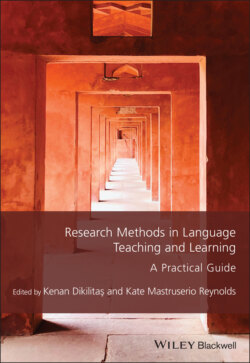Читать книгу Research Methods in Language Teaching and Learning - Группа авторов - Страница 58
Research Issues
ОглавлениеResearchers need to address several issues to improve the quality of their research. An important criterion for good qualitative research is trustworthiness, which is mainly determined by “…whether the data analyses, reports and interpretations constitute honest and authentic reconstruction of the research…” (Burns, 2010b, p. 85). To ensure trustworthiness, researchers are expected to report their research (e.g., research context, and data research procedures) in a detailed, fair, and unbiased way (Burns, 1999; McKay, 2006; Patton, 1980). To address these issues, my dissertation and our articles presented detailed information regarding the context, problems, procedures, data collection tools, and finding of the research.
Some of the criteria for trustworthiness are credibility, dependability, and transferability (Lincoln & Guba, 1985). While credibility concerns whether the research findings are true and plausible, dependability is about the stability of the findings over time. To address these criteria, our research comprised eight interventions throughout a term to make sure that the data were comprehensive, and the findings were consistent. On the other hand, transferability refers to the applicability of the research to other contexts (McKay, 2006). Providing a detailed description of the research procedure is a significant way of increasing transferability.
A common way of ensuring the quality of qualitative research is using triangulation. According to Burns (1999), triangulation is a means of promoting the trustworthiness of a research study through including multiple perspectives on the topic under investigation. Triangulation is the combination of several observers, methods, and data sources (Denzin, 1970, cited in Patton, 1980), and, hence, makes it possible to avoid presuppositions or biases when drawing conclusions and reflecting on the data gathered (Burns, 2010a).
Patton (1980) proposed four types of triangulation: “methods triangulation,” “triangulation of sources,” “analyst triangulation,” and “theory/perspective triangulation.” While methods triangulation is collecting both quantitative and qualitative data, triangulation of sources involves using different qualitative data collection tools with the aim of checking whether these lead to similar findings. Analyst triangulation is the involvement of more people in the data analysis stage, and theory triangulation implies addressing different theoretical perspectives to analyze the same data set (Patton, 1980). My doctoral research rested upon methods triangulation and triangulation of sources, since both qualitative and quantitative data were collected by using four different methods.
From a narrower perspective, the quality of an action research study depends on the extent to which it improves educational practices (Burns, 1999). According to this assumption, our research can be considered beneficial, because the interventions had a positive impact on issues relevant to the effectiveness of EFL speaking classes. In addition to the criteria that are mentioned above, Burns (1999) synthesized different qualitative criteria for action research studies (Table 3.3).
Table 3.3 Validity criteria for action research (Burns, 1999, pp. 161–162)
| Validity type | The description | |
|---|---|---|
| 1. | Democratic validity | This criterion relates to the extent to which the research is truly collaborative and allows for the inclusion of multiple voices. |
| 2. | Outcome validity | This criterion relates to the notion of actions leading to outcomes that are “successful” within the research context. |
| 3. | Process validity | This criterion raises questions about the “dependability” and “competency of the research.” Key question here is: Is it possible to determine how adequate the process of conducting the research is? |
| 4. | Catalytic validity | This criterion relates to the extent to which the research allows participants to deepen their understanding of the social realities of the context and how they can make changes within it. |
| 5. | Dialogic validity | This criterion is parallel to the process of peer review, which is commonly used in academic research. Typically, the value or “goodness” of the research is monitored by peer review for publication in academic journals. |
The research had democratic validity, because the researcher and the teacher worked collaboratively in designing classes based on the data collected from students. It also had process validity since the research process lasted a term. Catalytic validity was relevant to the research topic because student negotiation encouraged participants to be critical about the usefulness of class designs and reflect on their engagement in speaking activities. Dialogic validity was also fulfilled in the study as the research was carried out under the supervision of two specialists.
